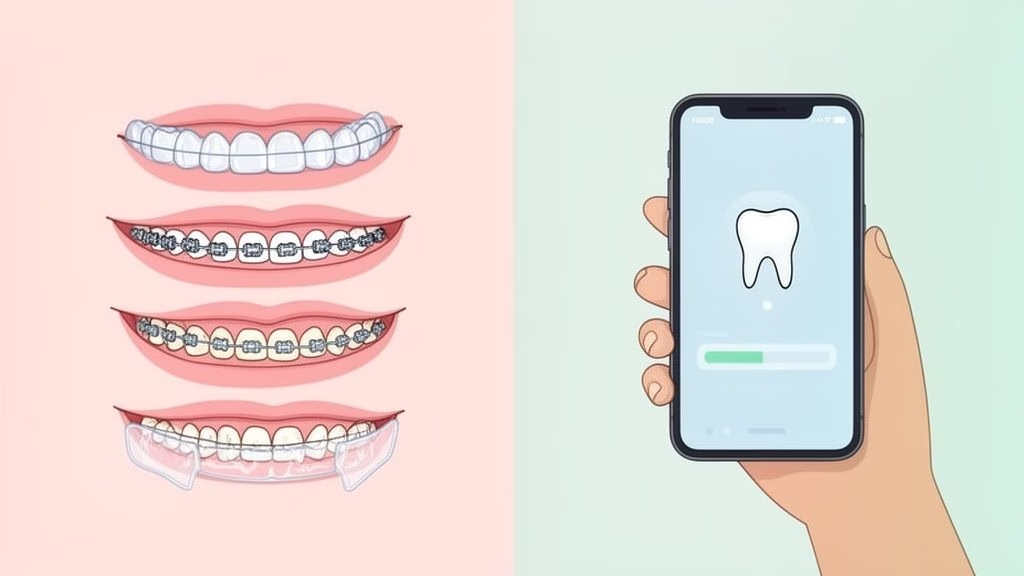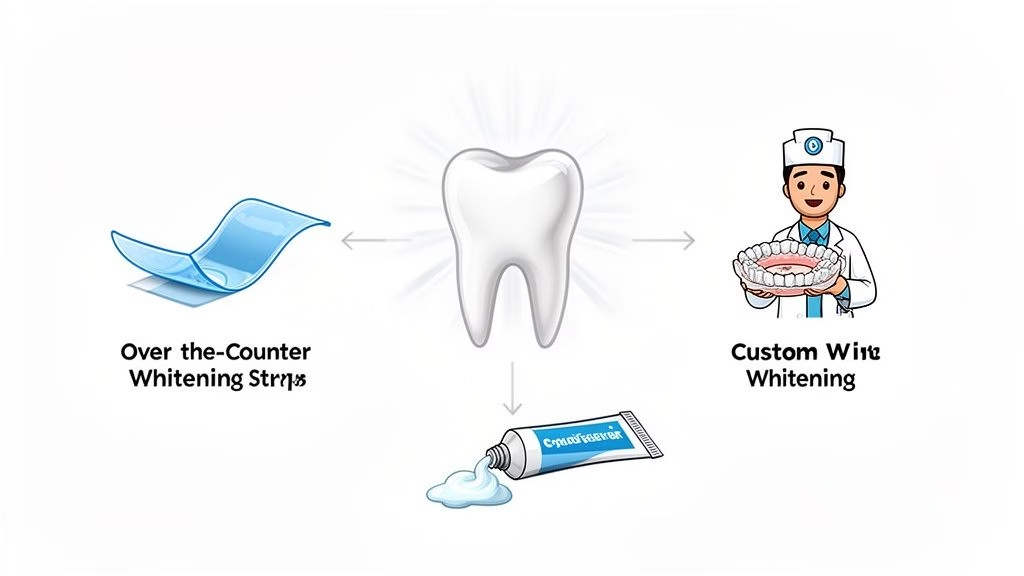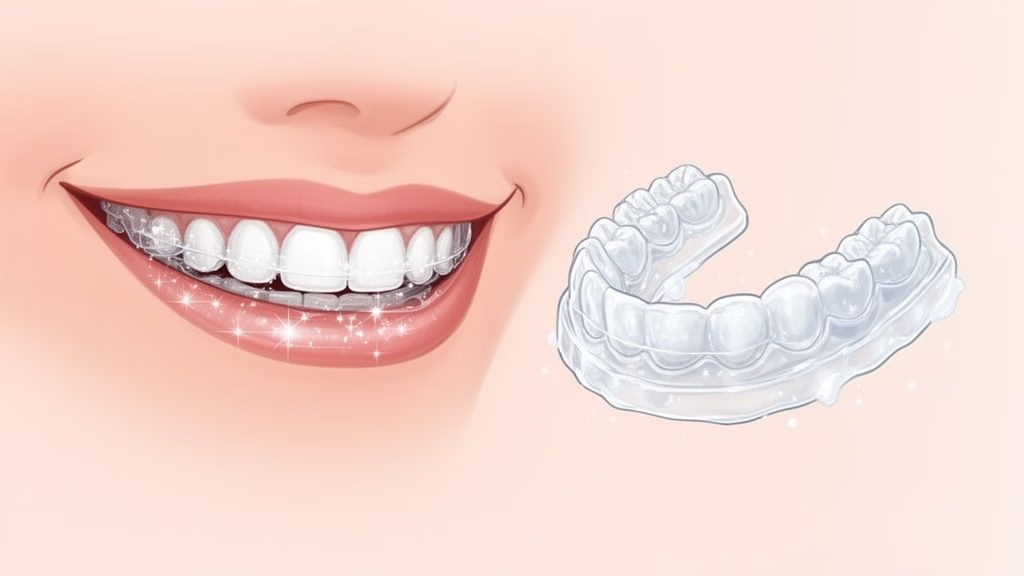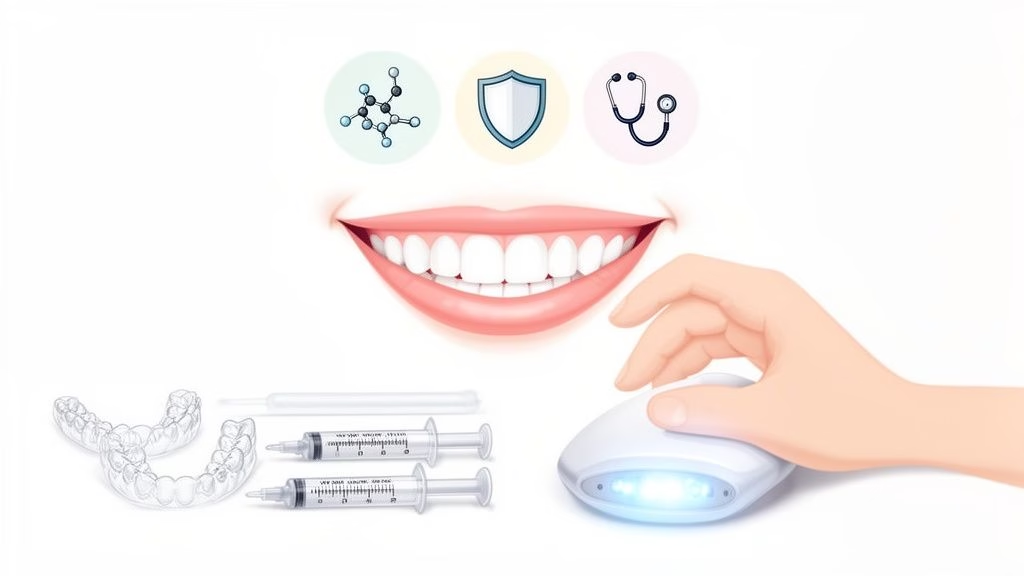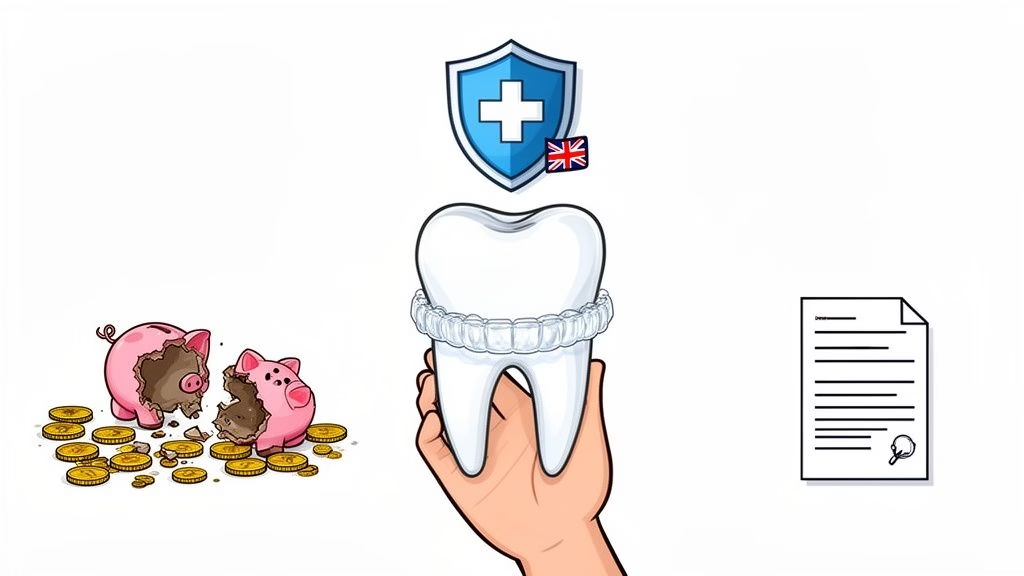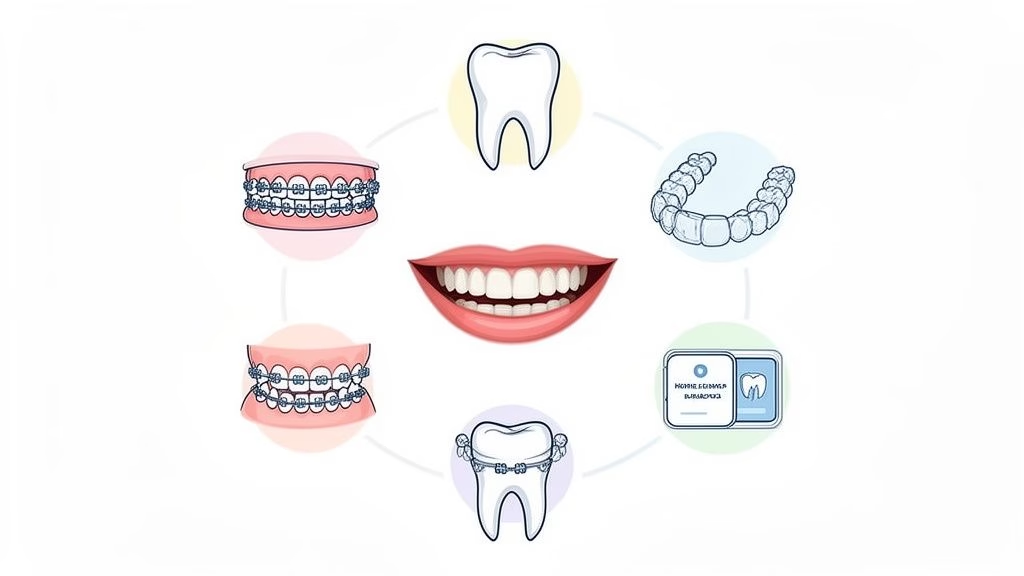What Causes White Spots on Teeth and How to Fix Them
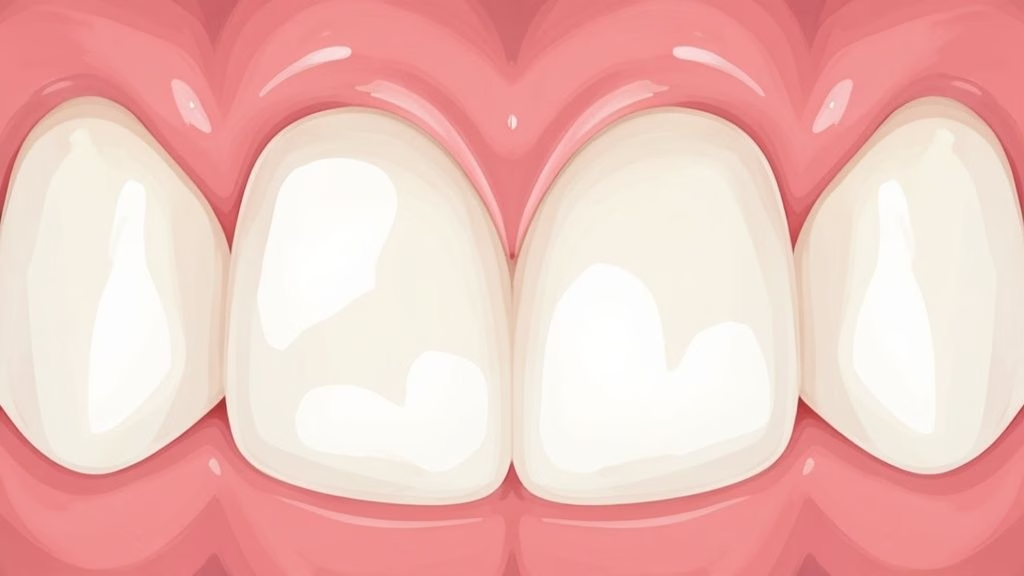
If you’ve ever spotted chalky white marks on your teeth, you’re looking at an early warning sign from your enamel. Think of these spots as a signal that your tooth’s surface is losing essential minerals – a process called enamel demineralisation.
The culprit can be anything from plaque build-up to getting a bit too much fluoride as a child. Sometimes, it’s just down to the way your enamel formed in the first place.
Your Quick Guide to White Spots on Teeth
Ever catch your reflection and notice little opaque white patches on your smile? It’s really common, but figuring out why they’re there is the first step to getting rid of them.
Essentially, these spots are just areas where the mineral content of your enamel has changed. This shift alters the way light bounces off the tooth, making that patch look distinctly different from the rest of your smile.
It’s natural to worry, but it’s essential to know these spots aren’t automatically cavities. They can pop up for all sorts of reasons. For example, you might see them after fixing braces, since cleaning around the brackets can be a real challenge. Those little white marks have been there for others since they were kids.
The good news? You have options. No matter what caused them, modern dentistry has clever ways to restore a bright, even-toned smile.
The Three Main Culprits
Understanding the three main paths to white spots helps one better understand what’s going on.

As you can see, the causes fall into three distinct buckets: problems from mineral loss (demineralisation), issues from tooth development (fluorosis), and structural defects in the enamel itself (hypoplasia).
Knowing which one you’re dealing with is crucial, because the right treatment depends entirely on pinpointing the correct underlying cause.
To help you get a clearer picture, here’s a quick summary of what to look for.
Of course, figuring out the exact reason for your white spots needs a professional eye.
Thankfully, getting a proper diagnosis has never been simpler. With the Toothfairy app, you can chat with a qualified UK dentist right from your phone. It’s a smarter, more affordable way to get expert advice on cosmetic work, dental emergencies, or teeth straightening.
How Plaque Buildup Wears Down Your Tooth Enamel

One of the most common—and preventable—causes of those chalky white spots is something we all battle daily: plaque. It’s best to think of plaque as a sticky, acidic film that smothers your teeth. If you don’t clear it away, it becomes a hotbed for acid production, laying the groundwork for those noticeable marks to form.
The whole process kicks off with the bacteria naturally living in your mouth. They love to feed on sugars and starches from your diet, and as they metabolise these foods, they produce acid as a waste product. This acid is the real enemy, as it directly attacks the tough, protective outer layer of your teeth, the enamel.
Over time, this constant acid exposure begins to leech essential minerals like calcium and phosphate right out of your enamel. In the UK, this process, known as enamel demineralisation, is often a direct result of subpar oral hygiene. According to the NHS, these white spots are frequently the very first warning sign of tooth decay.
What’s Actually Happening to the Tooth?
So, why does losing minerals make a spot turn white? It all comes down to how light plays off the surface of your tooth. Healthy enamel is tightly packed with minerals, which makes it slightly translucent. This allows light to pass through to the dentine underneath, giving your teeth their natural, pearly shade.
But when demineralisation occurs, the enamel’s structure becomes porous and rough at a microscopic level. This altered texture changes everything. Instead of passing through, light scatters and reflects off the now-uneven surface. The result is that chalky, opaque white appearance that stands out so starkly against the rest of the healthy tooth.
Key Takeaway: A white spot caused by plaque isn’t a stain. It’s a physical change in your enamel’s texture and density due to acid erosion. It’s a weak spot, and a clear signal that the area is vulnerable to a cavity.
Your Best Defence Is a Good Offence
It sounds simple, but the most effective way to stop these white spots is to break down that plaque film before it can get to work. Your number one tool for this is a consistent, thorough oral hygiene routine.
Here’s what you can do to keep your enamel strong and healthy:
- Brush properly: Make sure you’re brushing for at least two minutes, twice a day. The goal is to clean every single surface of every tooth, especially along the gumline where plaque loves to accumulate.
- Don’t forget to floss: Your toothbrush can’t get into the tight spaces between your teeth. Flossing once a day is crucial for clearing out trapped food particles and plaque, stopping that acid production in its tracks.
- Watch the sugar: Limiting sugary foods and drinks starves the acid-producing bacteria of their favourite fuel. This gives your enamel a much better chance to stay fully mineralised.
If you’re worried your current routine isn’t quite cutting it, a little expert guidance can go a long way. With the Toothfairy app, you can book a virtual chat with a registered dentist. They can take a look at your routine, assess your specific needs, and give you personalised advice to get your hygiene habits spot-on—preventing white spots before they even have a chance to appear.
Why Braces Can Sometimes Leave White Spots Behind
That long-awaited day when your braces finally come off should be all about celebrating your new, straight smile. But for many, that joy is tinged with disappointment when they spot small, chalky white squares where the brackets used to be.
It’s a surprisingly common outcome with traditional fixed braces, and it all comes down to plaque. The intricate grid of brackets and wires creates the perfect hiding place for bacteria and food particles to build up. Think of it as a minefield for your toothbrush—it’s incredibly tough to navigate and clean every single surface.
When plaque sits on your tooth enamel for too long, the acids it produces start to leach out essential minerals. This process, known as demineralisation, is what creates those tell-tale white spots that are a perfect outline of where your brace brackets were.
The Challenge of Cleaning Around Fixed Braces
Let’s be honest, keeping your teeth perfectly clean with fixed braces is a real chore. The brackets essentially act as tiny shields, blocking your toothbrush from reaching the enamel directly underneath and around them. Flossing turns into a complex, time-consuming task that requires special tools and a whole lot of patience.
This is precisely why these white spot lesions (or WSLs, as dentists call them) are so frequent after orthodontic treatment. A 2013 study from a UK dental hospital really puts it into perspective: a staggering 42% of patients with fixed braces had at least one new white spot when their treatment was over. For those with poor oral hygiene, the risk was 8.55 times higher than for those who kept their teeth spotless. You can read more about these orthodontic findings here.
This isn’t just about aesthetics. Those white spots represent weakened enamel, leaving those areas of your teeth far more vulnerable to cavities down the line if cleaning habits don’t improve.
A Modern Approach to Straighter, Healthier Teeth
Thankfully, orthodontics has evolved. The cleaning challenges that come with fixed braces have been neatly sidestepped by modern clear aligners, which offer a completely different way to straighten teeth.
Unlike old-school braces that are bonded to your teeth, clear aligners are designed to be removed. This simple change is a game-changer for your oral health. You just pop them out to eat, brush, and floss as you normally would, with nothing getting in the way.
Here’s why that makes such a difference:
- No hiding spots for plaque: You can brush and floss effectively, reaching every nook and cranny of every tooth.
- Better oral health: By properly removing plaque, you massively reduce the risk of demineralisation and decay.
- Peace of mind: You can focus on achieving a straighter smile without the nagging worry of what your teeth will look like underneath.
This is a huge reason why so many people are now opting for clear aligners over traditional methods or specific aligner brands. At Toothfairy, we offer a smarter, more affordable path to a straighter smile that doesn’t put your enamel’s health at risk. By choosing a removable option, you aren’t just investing in alignment; you’re protecting the bright, even colour of your teeth for the entire journey.
Understanding Fluorosis: When Good Minerals Go Wrong
Fluoride is one of dentistry’s biggest heroes. We celebrate it for its incredible ability to strengthen tooth enamel and fend off cavities. But, as with most things, there can be too much of a good thing. This is the curious case of dental fluorosis, a condition that often shows up as white spots on teeth.
It all comes down to timing. Fluorosis occurs when a child takes in too much fluoride while their adult teeth are still developing beneath the gums. This excess fluoride disrupts the cells responsible for building enamel, leading to a hiccup in the normal mineralisation process. The result? Permanent white streaks, delicate lacy lines, or more obvious cloudy patches on the teeth once they finally emerge.
It’s vital to understand that fluorosis isn’t a disease or a sign of decay. It’s a purely cosmetic condition that changes how the enamel looks, not its actual health. In the UK, it’s a common reason for white spots, especially among children. In fact, estimates suggest that mild fluorosis may affect around 10-15% of children living in areas with fluoridated water.
Protecting Your Child’s Developing Smile
The key to preventing fluorosis is simply finding that sweet spot with fluoride intake, particularly for young children. Little ones are still mastering their swallowing reflexes, so they naturally end up ingesting more toothpaste than we do. This is where parents and guardians can really step in and help.
Keeping fluoride levels in the safe zone is straightforward with a few easy-to-follow guidelines:
- For children under 3: A tiny smear of fluoride toothpaste is all you need—think the size of a single grain of rice.
- For children aged 3 to 6: A pea-sized amount is the perfect measure.
- Supervise brushing time: Encourage your child to spit out the excess toothpaste after brushing, rather than swallowing it.
By keeping an eye on how much toothpaste they use, you can easily avoid fluorosis while still giving their teeth the brilliant cavity protection that fluoride offers.
Key Takeaway: Fluorosis is a developmental issue, not a reflection of a person’s oral hygiene. These spots form long before the teeth even break through the gums and are entirely cosmetic.
Solutions for Existing Fluorosis Spots
If you’re an adult and have always been bothered by the appearance of fluorosis, you don’t just have to put up with it. Although the spots themselves are permanent, modern cosmetic dentistry has some fantastic and minimally invasive ways to help them blend in, giving you a more uniform and even-toned smile.
Treatments like microabrasion or resin infiltration are brilliant for masking these white patches without affecting the healthy tooth around them. And the best part? Getting a professional opinion has never been more straightforward or affordable. With the Toothfairy app, you can have a chat with a qualified UK dentist from the comfort of your own home, discuss your concerns, and explore the cosmetic solutions that are right for you.
Digging a Little Deeper: Less Common Causes of White Spots
While plaque and fluoride are usually the main culprits behind white spots, sometimes the root cause is something else entirely. A few developmental or dietary issues can also mess with your enamel’s appearance, and knowing what they are gives you a fuller picture of why these spots appear.
One of these is enamel hypoplasia. This is where the tooth enamel simply doesn’t form properly during childhood, leaving behind thin, weak, or even pitted areas. Unlike spots caused by plaque build-up, this is a structural problem that can be traced back to things like a childhood illness, a lack of certain nutrients, or even some medications taken while the teeth were still developing.
Other Things That Can Impact Your Enamel
It’s not just about specific developmental conditions; your day-to-day habits and overall health can also leave their mark. The food and drink you consume, for example, have a huge say in how strong and healthy your enamel looks over the years.
A diet packed with acidic foods and drinks—think citrus fruits, fizzy pop, and a lot of sports drinks—can wear away at your enamel directly. This erosion thins out the protective outer layer of the tooth, which can change its texture and the way it reflects light, sometimes resulting in discolouration that shows up as white spots.
Another specific developmental issue is known as Molar Incisor Hypomineralisation (MIH). This condition affects the quality of the enamel on the first permanent molars and incisors, making them much weaker and more likely to chip or crumble. The teeth affected often show creamy-white or yellowish-brown patches, which are tell-tale signs of enamel that hasn’t mineralised correctly.
It’s worth remembering that these conditions really need a professional eye to diagnose properly. A white spot from MIH looks very different to a dentist than one caused by fluorosis.
Whatever the reason behind the spots, figuring out the cause is the first step toward fixing them. Even for these less common issues, there are great cosmetic treatments available to get your smile looking smooth and even again. The best way forward is to get a professional opinion. With the Toothfairy app, you can chat with a UK-registered dentist for an affordable assessment right from your phone and get started on the path to a smile you feel great about.
Modern Treatments for an Even-Toned Smile
Pinpointing the cause of white spots is the first hurdle, but the next step is finding the right solution to bring back your smile’s even colour. The good news is that modern dentistry has some fantastic, minimally invasive treatments that can blend or remove these patches without jumping straight to complex procedures.
These techniques are designed to tackle the specific cause of your white spots, whether it’s mineral loss from plaque, developmental fluorosis, or enamel hypoplasia. The aim is always the same: achieve a natural, uniform look while keeping as much of your healthy tooth structure as possible.
Microabrasion for Surface-Level Spots
You can think of microabrasion as a very gentle, precise polishing for your teeth. This procedure is perfect for superficial white spots, such as those from mild fluorosis or the earliest signs of demineralisation. Your dentist will use a special paste containing fine abrasive particles to carefully remove a microscopic layer of enamel.
This process smooths out the tooth’s surface and buffs away the discoloured top layer, letting the healthy enamel underneath shine through. It’s a quick, painless, and remarkably effective method for dealing with surface-level marks, revealing a much more consistent smile.
ICON Resin Infiltration for Deeper Marks
When white spots have settled a bit deeper into the enamel, ICON resin infiltration is a brilliant, innovative option. This treatment is especially good for the chalky marks often left behind after fixed braces, as it gets right to the root of the problem by targeting the porous enamel.
The whole process is clever and, best of all, completely drill-free. First, the tooth is prepared with a gel that opens up the tiny pores within the white spot. Next, a very fluid, tooth-coloured resin is applied. It seeps deep into the porous lesion and is then hardened with a special light.
This resin fills the microscopic gaps in the enamel, which fundamentally changes how light reflects off the tooth. The result? The white spot visually disappears, blending seamlessly with the surrounding tooth.
Professional Teeth Whitening Considerations
Sometimes, professional teeth whitening can be part of the puzzle, but it’s rarely a standalone fix for white spots. While whitening treatments lighten the overall shade of your teeth, they also lighten the white spots. This can sometimes make the contrast between the spot and the rest of the tooth even more noticeable.
That said, when whitening is used strategically alongside other treatments like ICON, it can help create a beautifully balanced and bright final look. A professional assessment is absolutely essential to figure out if this is the right path for you.
At Toothfairy, we believe getting expert cosmetic dental care should be straightforward and accessible. The Toothfairy app puts you in direct contact with UK-registered dentists who can assess your smile, diagnose the cause of your white spots, and create the best treatment plan. You’ll get a transparent quote and find a local partner clinic to carry out the work, all from your phone. It’s a smarter way to get the even-toned smile you deserve, without all the usual hassle.
Your Questions About White Spots, Answered
Once you understand what’s causing those little white marks, a few more questions usually pop up. Let’s tackle the most common ones so you can feel clear and confident about what to do next.
Will White Spots on Teeth Go Away By Themselves?
In short, probably not. White spots from demineralisation, fluorosis, or hypoplasia are essentially permanent changes in the structure of your tooth enamel. While fantastic oral hygiene can prevent them from getting worse or turning into cavities, the spots themselves won’t just fade away without professional intervention.
Think of it as a small, faint scar on your tooth—it’s a physical mark left behind. To actually make it disappear, you’ll need a specific cosmetic treatment designed to restore the enamel’s consistent colour.
Is Teeth Whitening a Good Idea for White Spots?
This is a really common question, and the answer isn’t always straightforward. While whitening treatments do lighten your teeth, they lighten everything, including the white spots. This can sometimes make the contrast between the spot and the rest of the tooth even more noticeable.
In some very mild cases, whitening can help everything blend a bit better. For most people, though, a more targeted approach like ICON resin infiltration or microabrasion will give a much more even and predictable result.
There’s no one-size-fits-all answer here. A professional consultation is the only way to know for sure what will work for you. A dentist can properly assess the cause and depth of your spots and map out the best path to an even-toned smile.
How Can I Prevent White Spots on My Child’s Teeth?
When it comes to kids, prevention is absolutely the best medicine. Protecting their developing teeth is simpler than you might think and boils down to a few key habits.
- Preventing fluorosis: Use only a tiny smear of fluoride toothpaste for children under three. A pea-sized amount is all they need for kids between three and six. The most important part is supervising them while brushing to ensure they spit the toothpaste out instead of swallowing it.
- Preventing plaque-related spots starts with a solid, consistent brushing and flossing routine. This becomes non-negotiable if they have braces, which are notorious for trapping plaque. Limiting sugary foods and drinks is another huge factor in keeping their enamel strong and spot-free.
Ready to get rid of those white spots and feel great about your smile? The Toothfairy app makes getting expert advice incredibly simple. You can connect with a UK-registered dentist for a professional assessment and discuss your treatment options from your home. Download the app today at https://www.toothfairyapp.co.uk.
Last updated on September 27, 2025

Kian Dhinsa
Dr. Kian Dhinsa is a Birmingham-based dental practitioner with a special interest in orthodontics, general dentistry, and and surgery.
He has been recipient of numerous awards, for dental care and digital innovation.
Kian Dhinsa
Dr. Kian Dhinsa is a Birmingham-based dental practitioner with a special interest in orthodontics, general dentistry, and and surgery. He has been recipient of numerous awards, for dental care and digital innovation.
